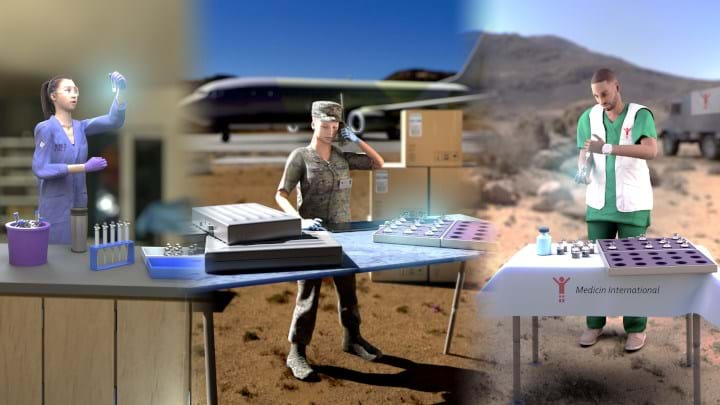Increasing yield for portable vaccine production method

RESEARCHERS at Northwestern University, US have discovered a way to improve their new protein-based vaccine manufacturing method, which could help to broaden access to potentially life-saving medicines that can combat antibiotic-resistant bacteria, and viruses.
Previously, the team developed a modular technology called in-vitro conjugate vaccine expression (iVAX), a cell-free platform for vaccine production. Michael Jewett explained that conjugate vaccines combine weak antigens, such as the polysaccharide antigen of a pathogenic bacteria, with a strong antigen, an immunogenic carrier protein. Michael Jewett is the Walter P. Murphy Professor of Chemical and Biological Engineering and Director of the Center for Synthetic Biology at Northwestern.
iVAX is made possible through cell-free synthetic biology. Bacteria are grown containing the components for a pathogen-specific polysaccharide and an oligosaccharyltransferase enzyme, needed to join the sugar to a protein. The cell membranes are ruptured and the resulting lysate mixture contains all of the components needed for vaccine production, which can then be freeze dried for transport and storage. According to Jewett, the freeze-dried cell-free system remains shelf-stable for at least three months at room temperature. Vaccine production can then be triggered when needed by adding water and DNA encoding the vaccine protein of interest, such as an FDA carrier protein.
In their recent work, the team discovered that by enriching the cell extracts with vesicles, production yield could be increased. On rupturing, the bacterial cell membranes reform into smaller structure known as vesicles which will carry the components needed for vaccine manufacture, including membrane-bound enzymes and the O-antigen polysaccharide.
The number of vesicles in extracts was increased based on the methods used for extract processing. Cells were broken up either using sound energy to agitate them, or physically broken apart using a tool known as a homogeniser. Samples were then subjected to centrifugation at a force of 12,000g (termed S12 extracts) or 30,000g (S30 extracts). Initial tests showed that the highest number of vesicles were seen in S12 extracts when cells were homogenised. Homogenised S12 extracts contained 6.5±0.3×1012 particles/mL compared to 3.4±0.1×1012 particles/mL in the base case (homogenised S30 extracts).
Testing N-linked glycosylation required for conjugate vaccine production, after 60 minutes, the S12 extracts were able to yield 117.2±9.9 µg/ml of glycoprotein, representing a 91% increase compared to the S30. N-linked glycosylation involves adding an oligosaccharide to a nitrogen atom of an asparagine residue in the protein.
The long-term goal of this work is to use it for a diverse range of glycoproteins, so the researchers also tested it for O-linked glycosylation, and to produce three other glycoproteins, and similarly found that S12 extracts increased glycoprotein yield.
By increasing yield, researchers lowered the cost of vaccine production which should help facilitate greater access, according to Jewett. In their previous work, the team achieved a cost of US$5/dose. In light of the present work, the team could achieve production of 40,000 doses/day per litre of reaction batch at about US$1/dose.
That means that, in theory, the team could use a 1,000 L reactor to generate 40m doses/day, reaching 1bn doses in less than a month.
Through this work, the researchers set the stage for addressing the issue of rising antibiotic resistance, and to combat new viruses.
Currently, the researchers are working to make protective conjugate vaccines against additional pathogenic bacteria, as well as to further lower costs and extend the shelf life of their systems. They also hope to develop partnerships with industry to facilitate scaleup.
Jewett commented that iVAX offers a compelling solution to existing limitations of cell-based manufacturing, which include high product variability; inconsistency between batches; high costs of centralised facilities needed for good manufacturing practice; the time needed to go from the finalised DNA sequence to vials of drugs (at least 18 months); the possibility of wasting materials, labour, and money as the protein medicines have to be prepared in advance of an anticipated, specific threat; and the distribution is limited due to cold-chain requirements.
“iVAX based cell-free systems address these limitations,” said Jewett.
“Indeed, [it] offers a new approach. iVAX is a cell-free platform for portable, on-demand, and scalable production of protective conjugate vaccines. We believe this will allow timely response to emergent/pandemic threats and enable distributed biomanufacturing anywhere on earth and beyond.”
Nature Communications: https://doi.org/gbbj
Recent Editions
Catch up on the latest news, views and jobs from The Chemical Engineer. Below are the four latest issues. View a wider selection of the archive from within the Magazine section of this site.




